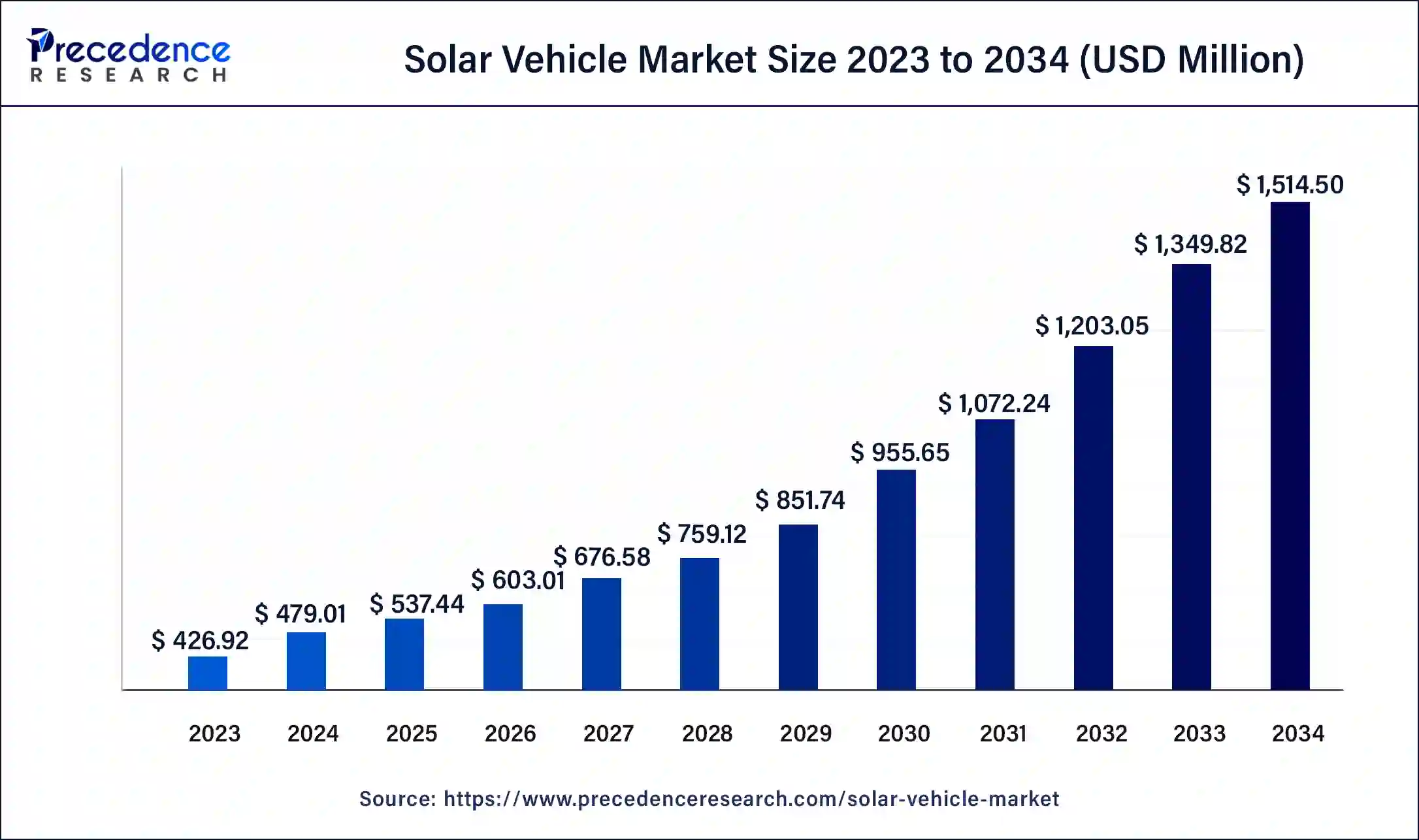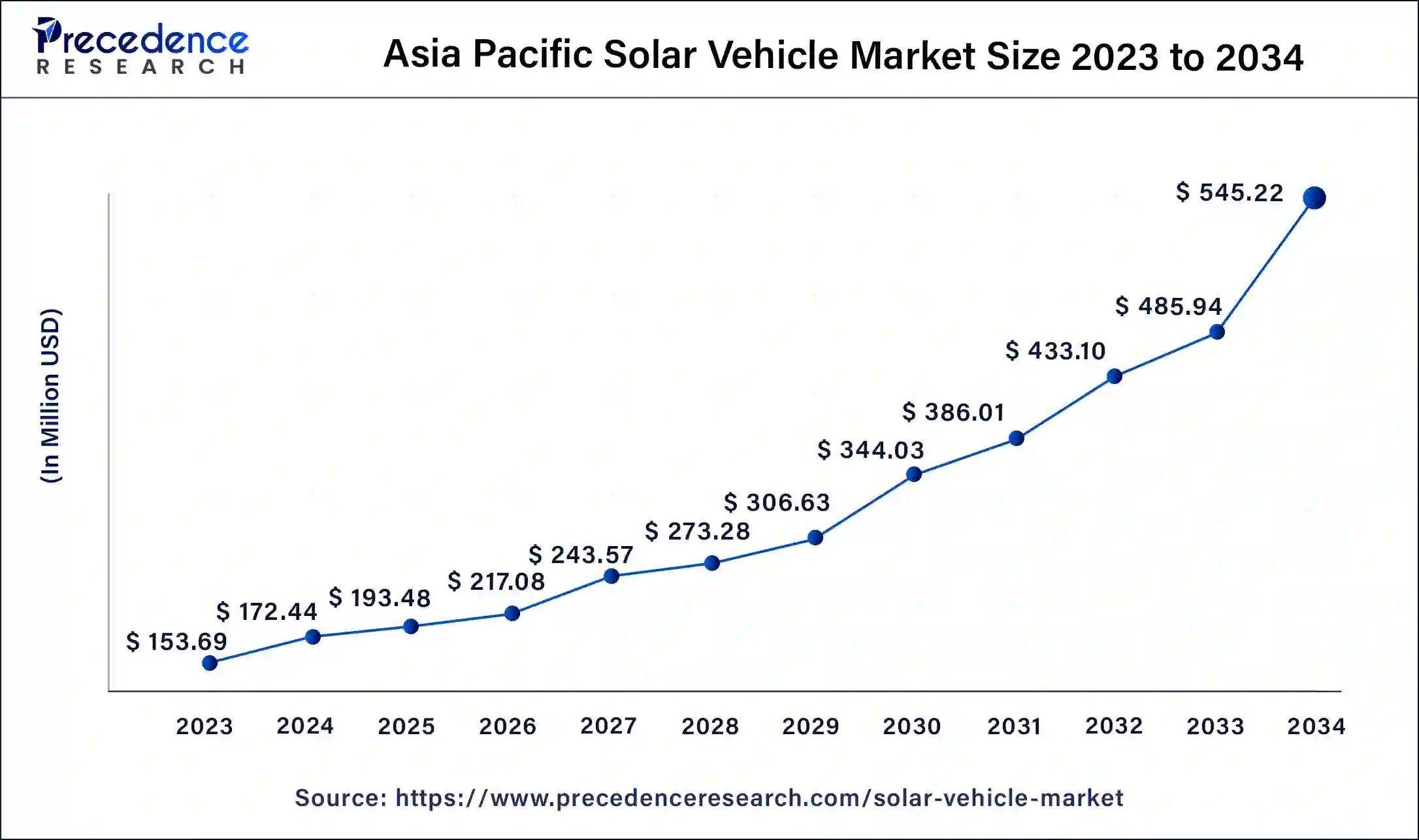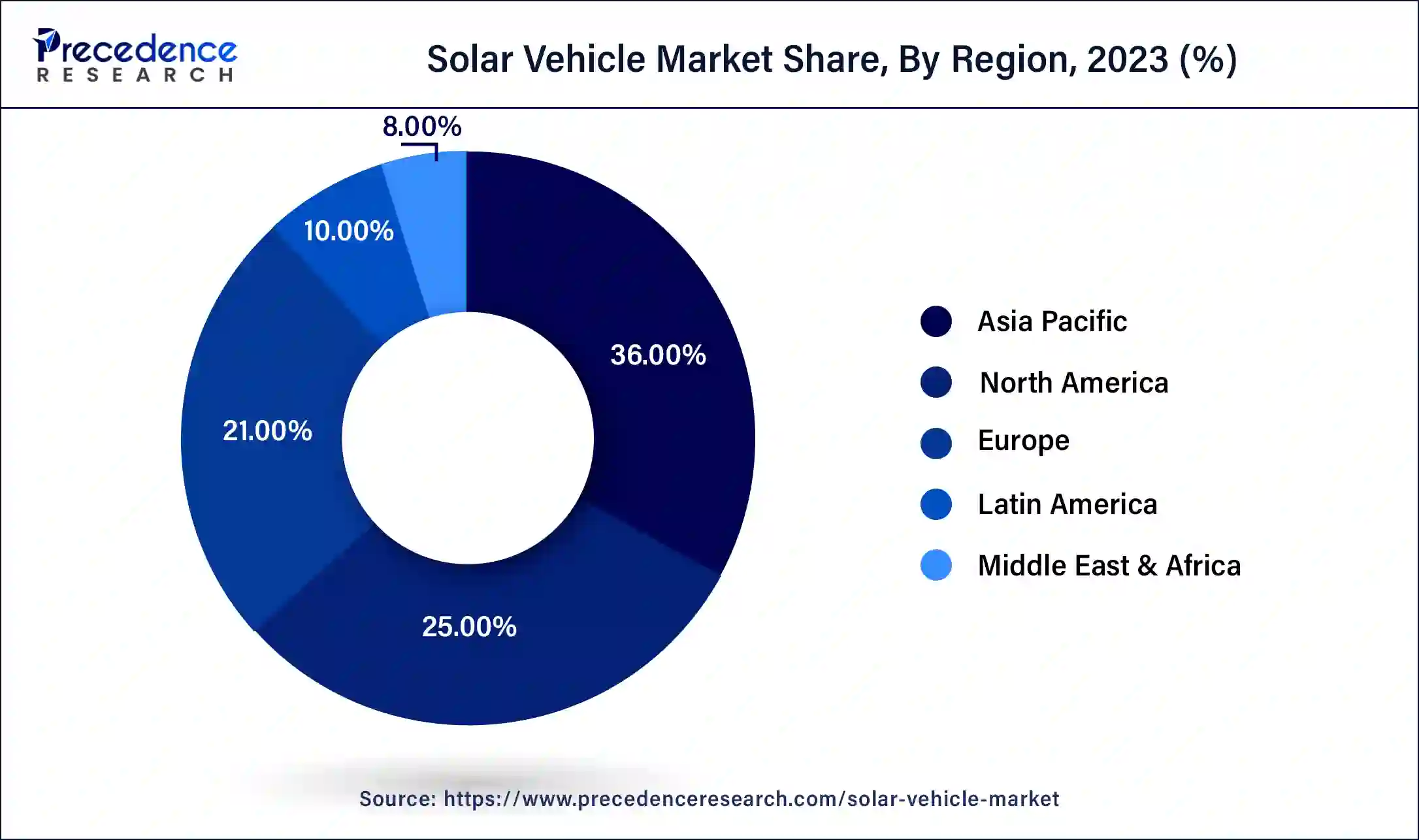October 2024
The global solar vehicle market size was USD 426.92 million in 2023, calculated at USD 479.01 million in 2024 and is expected to reach around USD 1,514.50 million by 2034, expanding at a CAGR of 12.2% from 2024 to 2034.
The global solar vehicle market size accounted for USD 479.01 million in 2024 and is expected to reach around USD 1,514.50 million by 2034, expanding at a CAGR of 12.2% from 2024 to 2034.

The Asia Pacific solar vehicle market size was estimated at USD 153.69 million in 2023 and is predicted to be worth around USD 545.22 million by 2034, at a CAGR of 12.4% from 2024 to 2034.

Based on region, Asia Pacific dominated the global solar vehicle market in 2023, in terms of revenue and is estimated to sustain its dominance during the forecast period.The stringent government regulations to restrict the carbon missions has significantly boosting the demand for the solar vehicle in the region. Moreover, the vehicle manufacturers are increasingly focusing on the production of the efficient solar vehicles that is expected to foster the market growth during the forecast period.

On the other hand, Europe is estimated to be the most opportunistic segment during the forecast period. The presence of developed nations like Germany, France, and Italy, high disposable income, improved living standards, and increased awareness regarding the rising pollution levels are the major factors that propelled the growth of the solar vehicle market in Europe. Moreover, rising government initiatives to shift towards the clean transport is a major driving force that will fuel the growth of the market in this region.
Solar vehicle is an electric vehicle that is equipped with photovoltaic cells in the solar panels that converts the solar energy into electric energy. The technological advancements and growing adoption of innovative technologies in the automotive industry has fostered the growth of the global solar vehicle market. The higher dependence on the biofuels and the rising levels of air pollution owing to the carbon emissions has resulted in the adoption of the solar vehicles across the global markets.The automotive is a huge industry and the significant adoption of the vehicles among the population had highlighted the concerns over the depleting non-renewable energy sources. Therefore, the increased need to shift towards the renewable sources of energy and fuel is a prominent driver of the global solar vehicle market. The government initiatives to reduce carbon footprint and the rising investments on the research and development of the eco-friendly and renewables sources of energy have encouraged the growth of the solar vehicle market. Solar or electric vehicle is gaining rapid surge in the popularity among the global consumers which is expected to drive the growth of the global solar vehicle market.
The rising popularity of the self-charging vehicles have boosted the adoption of the solar vehicles. The rising demand for the emission free vehicle is a major factor that augments the market demand. The rising fuel prices results in the inflation and the majority of the daily used goods and services becomes more expensive. The surging need for the sustainable and affordable fuel sources is boosting the demand for the solar vehicles. Further, the development of the fuel efficient vehicles have fostered the growth of the commercial and passenger solar vehicles. The rising government investments for the development of alternative fuel vehicles like public buses and other transit vehicles for public is augmenting the growth of the solar vehicle. The stringent government regulations regarding the emission from the vehicles is positively impacting the market and is expected to boost the adoption of the solar vehicles across the globe.
| Report Coverage | Details |
| Market Size in 2023 | USD 426.92 Million |
| Market Size in 2024 | USD 479.01 Million |
| Market Size by 2034 | USD 1,514.50 Million |
| Growth Rate From 2024 to 2034 | CAGR of 12.2% |
| Largest Market | Asia Pacific |
| Base Year | 2023 |
| Forecast Period | 2024 to 2034 |
| Segments Covered | Vehicle Type, Electric Vehicle Type, Battery Type, Region |
| Regions Covered | North America, Asia Pacific, Europe, Latin America, Middle East and Africa |
Based on the vehicle type, the passenger vehicles segment dominated the global solar vehicle market in 2023, in terms of revenue and is estimated to sustain its dominance during the forecast period. This is attributed to the increased adoption of the passenger cars among the population owing to the increased disposable income, increased environment consciousness, changing demographics, and increased demand for the sustainable personal commute solutions. Moreover, the rising popularity of the electric powered passenger vehicles across the globe is fueling the growth of the segment. The passenger segment will dominate in throughout the forecast period owing to the rising awareness among the population regarding the benefits of adopting renewable sources of energy as fuel for the vehicles.
On the other hand, the commercial is estimated to be the most opportunistic segment during the forecast period. The rising government investments in the development of the fuel efficient and sustainable public transport solution is resulting in the burgeoning demand for the alternative fuel vehicle across the globe.
Based on the electric vehicle type, the hybrid electric vehicle (HEV) segment dominated the global solar vehicle market in 2023, in terms of revenue and is estimated to sustain its dominance during the forecast period. This is majorly due to the ability of the HEVs to operate using different types and sources of fuel. The rising awareness regarding the drowning health of the environment owing to the rising level of vehicle emissions has significantly driven the adoption of the HEVs across the globe.
On the other hand, the BEV segment is estimated to be the most opportunistic segment owing to the rapidly growing infrastructure for the adoption of EVs across the globe. The market players are investing in creating an ecosystem for the EVs by setting up charging stations at various locations that may boost the growth of the BEV growth.
Based on the battery type, the lithium-ion segment dominated the global solar vehicle market in 2023, in terms of revenue and is estimated to sustain its dominance during the forecast period. This is attributed to the increased adoption of the lithium-ion batteries in the EVs owing to its light weight high energy density. Lithium-ion batteries have become a prominent battery in the EVs in the past few years and is also expected to be the fastest-growing segment as it provides longer range to the vehicles.
The market is moderately fragmented with the presence of several local companies. These market players are striving to gain higher market share by adopting strategies, such as investments, partnerships, and acquisitions & mergers. Companies are also spending on the development of improved products. Moreover, they are also focusing on maintaining competitive pricing.
In July 2021, Lightyear and Valmet Automotive entered into an agreement to manufacture solar vehicles together and agreed to produce around 1,000 solar vehicles per year.
The various developmental strategies like new product launches, acquisitions, and partnerships fosters market growth and offers lucrative growth opportunities to the market players.
Segments Covered in the Report
By Vehicle Type
By Electric Vehicle Type
By Battery Type
By Solar Panel
By Geography
For inquiries regarding discounts, bulk purchases, or customization requests, please contact us at sales@precedenceresearch.com
No cookie-cutter, only authentic analysis – take the 1st step to become a Precedence Research client
October 2024
January 2025
August 2024
January 2025